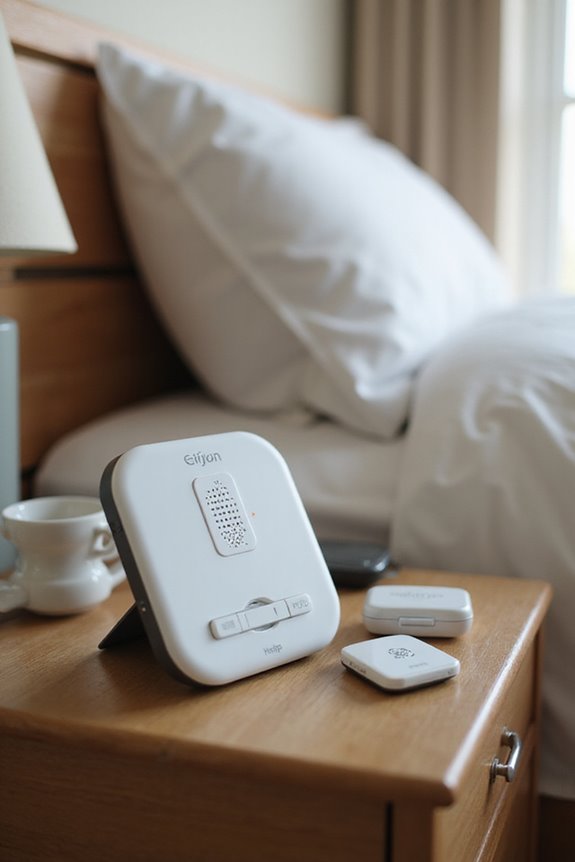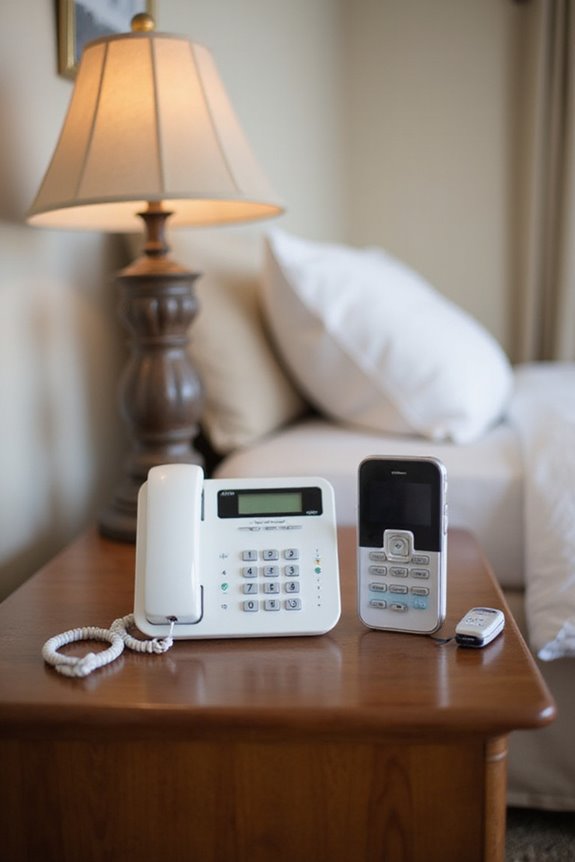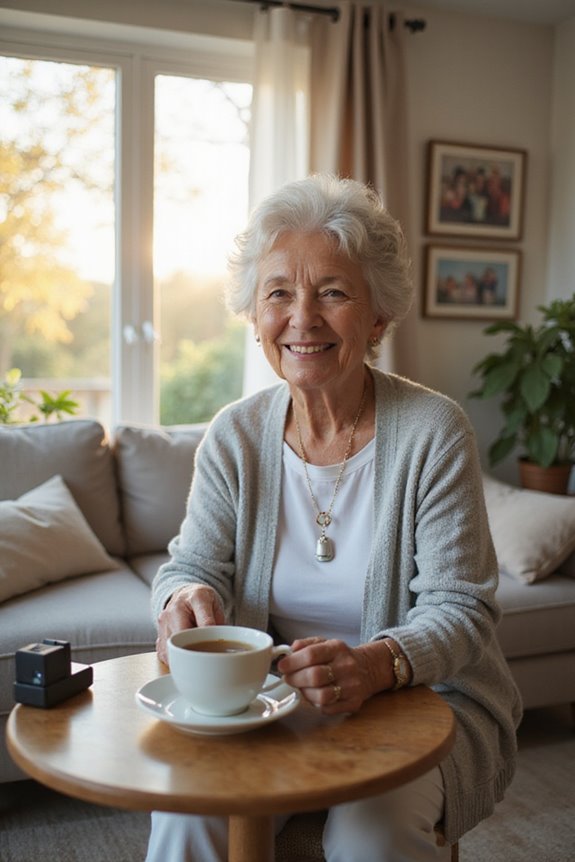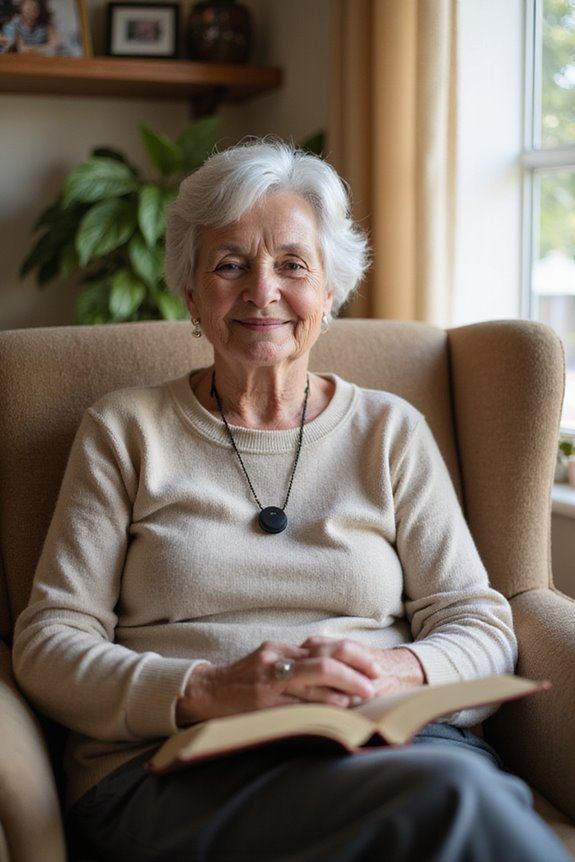Medical alert systems for seniors living alone enhance safety and independence. Key features include 24/7 monitoring, automatic fall detection, and two-way communication. Top providers include Bay Alarm Medical, starting at $24.95/month, and LifeFone, offering versatile systems with fall detection. Equipment fees vary from $0 to $200, and service plans can range from $24.95 to $49.45/month. Understanding individual lifestyle needs is essential for selection. Further insights into features and comparisons are available for informed decisions.
Key Takeaways
- In-Home Systems: Ideal for seniors primarily indoors, offering reliable emergency communication via landline or cellular connections.
- Mobile Systems: Provide GPS tracking and portability, ensuring safety for active seniors who spend time outside their homes.
- Automatic Fall Detection: Essential for immediate alerts, enhancing safety by notifying emergency responders without requiring manual activation.
- Two-Way Communication: Allows seniors to communicate directly with monitoring personnel, ensuring assistance is always within reach.
- User-Friendly Interfaces: Simple controls and compatibility with assistive technologies improve usability, making systems more accessible for seniors living alone.
Understanding Medical Alert Systems
Medical alert systems serve as critical tools for seniors, enhancing their safety and independence. These systems utilize various activation methods, including wearable buttons, fall detection sensors, and voice commands, to guarantee prompt assistance when needed.
Once activated, users are connected to 24/7 monitoring centers staffed by trained professionals, facilitating immediate communication during emergencies.
Key features include two-way communication, enabling users to speak directly with monitoring personnel, and automated response protocols that assess situations and determine the necessity of contacting emergency services.
Additionally, users can cancel false alarms through communication with the monitoring center, guaranteeing accurate responses. Overall, medical alert systems provide a reliable safety net, allowing seniors to maintain their autonomy while guaranteeing their well-being is prioritized. Furthermore, many systems offer 24/7 monitoring to ensure immediate assistance is always available when needed.
Types of Medical Alert Systems

In-Home Systems
- Connect via landline or cellular network.
- Include a base station with a two-way speaker.
- Wearable devices often feature a help button.
Mobile Systems
- Designed for portability with GPS tracking.
- Allow users autonomy away from home.
- May include automatic fall detection.
Smartwatch Systems
- Combine medical alerts with smartwatch features.
- Require initial purchase and monthly fees.
GPS Systems
- Provide coverage both at home and on-the-go.
- Typically include continuous monitoring.
Specialized Systems
- Offer unique features like voice activation and environmental monitoring.
- May have higher equipment fees due to advanced capabilities. These systems often include automatic fall detection that alerts assistance without requiring the user to press a button.
Key Features to Look For

Identifying the key features of medical alert systems is essential for ensuring that seniors receive the best possible protection and support.
Monitoring and Emergency Response
- 24/7 monitoring by trained professionals.
- Emergency response capabilities, including communication with emergency services.
- Location determination for effective response.
Advanced Detection Capabilities
- Automatic fall detection and motion sensors.
- Health condition monitoring and activity tracking.
Location and Tracking
- GPS tracking for real-time location updates.
- Mobile app integration and geofencing alerts.
Communication and Notification
- Two-way communication through devices.
- Customizable contact lists for emergency alerts.
Durability and Maintenance
– Long-lasting battery life for ongoing protection.
These features combine monitoring technology and emergency communication to enhance safety for seniors living alone.
Top Providers for Medical Alert Systems

Provider Comparisons:
- Bay Alarm Medical: Prices start at $24.95 per month; offers GPS tracking.
- Medical Guardian: Starting at $31.95 per month; customizable solutions available.
- MobileHelp: Affordable plans with no contracts, beginning at competitive rates.
- LifeFone: Versatile systems with fall detection; pricing varies by features.
- Lifeline: Established industry leader; plans range from $29.95 to $39.95 monthly.
Service Reviews:
- Bay Alarm Medical and Lifeline are highly regarded for responsive monitoring.
- Medical Guardian is noted for advanced technology and customization options.
These insights facilitate informed decision-making for seniors and their families. Additionally, consider devices with GPS tracking for enhanced safety while outside the home.
Comparing Landline and Cellular Systems

Comparing landline and cellular medical alert systems reveals distinct advantages and disadvantages that cater to different needs.
Landline Advantages
- Generally less expensive than cellular systems.
- More reliable connectivity, unaffected by cellular coverage issues.
- Best suited for homebound seniors or those in areas with limited cellular reception.
Cellular Drawbacks
- Higher costs due to technology and service plans.
- Requires regular battery recharging, which may affect usability.
- Ideal for active seniors who travel or have unpredictable landline access.
Essential Features for Seniors Living Alone
Fall Prevention
- Automatic fall detection triggers alerts without user input, essential for those who may be unconscious.
- Sensors identify unusual movement patterns, reducing response time and complications post-fall.
Emergency Communication
- 24/7 professional monitoring guarantees immediate assistance through certified operators.
- Real-time GPS tracking locates seniors, particularly those with cognitive impairments, enhancing response efficiency.
- Integration with chronic condition management allows for continuous health monitoring, detecting irregularities early.
Accessibility Features
- User-friendly design includes voice activation and wearable buttons for those with dexterity issues.
- Long battery life and low-battery alerts maintain uninterrupted service, vital for emergency readiness.
- Incorporating two-way communication ensures seniors can speak directly with emergency services for effective assistance.
Safety and Reliability Considerations
Ensuring safety and reliability is paramount when evaluating medical alert systems for seniors. With 1 in 3 older adults experiencing accidental falls, the need for effective fall prevention measures is vital. Advanced fall detection technology, utilizing AI, considerably enhances detection accuracy during daily activities.
Key considerations include:
- Response Time: Systems like Bay Alarm Medical’s SOS Smartwatch boast a 10-second response time.
- Injury Risk: 16% of seniors who fall require medical care.
- Market Growth: The medical alert system market is projected to grow from $6.47 billion in 2020 to $20.95 billion by 2030.
- User Satisfaction: 86% of users feel these systems have saved lives.
These factors underline the importance of technology reliability in safeguarding seniors living alone.
User Reviews and Recommendations
User reviews and recommendations play a significant role in evaluating medical alert systems for seniors, particularly as safety and reliability remain top priorities.
- Highly Recommended Systems: ADT, Medical Guardian, Bay Alarm Medical, MobileHelp, and Lively receive positive user experiences due to reliability and service quality.
- Response Times: ADT boasts an average emergency response time of just 10 seconds.
- Device Features: ADT’s Medical Alert Plus includes loud speakers, enhancing communication for users with hearing loss.
- System Comparisons: Bay Alarm Medical is noted for competitive pricing, while LifeStation is recognized for ease of use and flexible contract options.
- Additional Services: Some systems offer extras, like Bay Alarm Medical’s SOS Mobile, which includes location sharing with emergency services.
Cost Analysis of Medical Alert Systems
Cost analysis of medical alert systems is essential for seniors and their families when considering safety options. Understanding the cost breakdown reveals monthly fees ranging from $20 to $60, with additional one-time activation or equipment fees between $0 and $200.
Pricing Comparisons:
- Medical Guardian: Starting at $36.95/month.
- ADT Medical Alert: Starting at $31.99/month with a $99 activation fee.
- Life Alert: Approximately $49.45/month.
- Bay Alarm Medical: Beginning at $24.95/month.
- MobileHelp: Starting at $24.95/month, with no equipment fees.
Factors influencing costs include service features, monitoring services, and equipment quality. Bundling services or opting for long-term commitments may provide discounts, offering further cost-effective considerations for families.
Making the Right Choice for Your Needs
How can seniors and their families navigate the complexities of choosing a medical alert system that aligns with individual needs?
First, they must assess lifestyle factors.
- In-home systems are beneficial for those primarily indoors, utilizing landline or cellular connections for emergency communication.
- Mobile systems are ideal for active seniors, offering mobile features like GPS tracking and emergency alerts outside the home.
User experience is vital; systems should feature:
- Two-way communication for immediate contact with responders.
- Fall detection technology for automatic alerts.
- Simple interfaces to enhance usability.
Additionally, consider compatibility with assistive technologies and the availability of caregiver apps for monitoring. Automatic fall detection can significantly enhance safety by notifying emergency services without manual activation.
Ultimately, selecting the right system hinges on evaluating personal circumstances and the desired level of coverage.
Frequently Asked Questions
Can I Use a Medical Alert System Without a Landline?
Medical alert systems can operate without a landline by utilizing mobile alert systems with cellular connectivity. This feature enhances accessibility, ensuring users remain connected to emergency services, fostering a sense of security and belonging in their environment.
How Long Does It Take to Install a Medical Alert System?
After receiving her medical alert system, Sarah found the installation time minimal. The setup process took under thirty minutes, following clear steps, allowing her to feel secure and connected almost immediately, enhancing her peace of mind.
Are Medical Alert Systems Waterproof?
Medical alert systems often include waterproof features, ensuring functionality during indoor usage, especially in moisture-prone areas like bathrooms. This capability fosters a sense of security, allowing users to feel safe and connected at all times.
Can I Take My Medical Alert Device While Traveling?
Traveling with a medical alert device is possible with careful consideration of device compatibility. Essential traveling tips include verifying coverage areas, ensuring GPS functionality, and registering travel plans to maintain effective monitoring and support during emergencies.
What Happens if I Accidentally Trigger the Alarm?
Ironically, triggering a false alarm can summon an entire emergency response team for a misunderstanding. Calm communication with operators is essential; swiftly clarifying the mistake helps maintain trust while ensuring that real emergencies receive timely attention.




